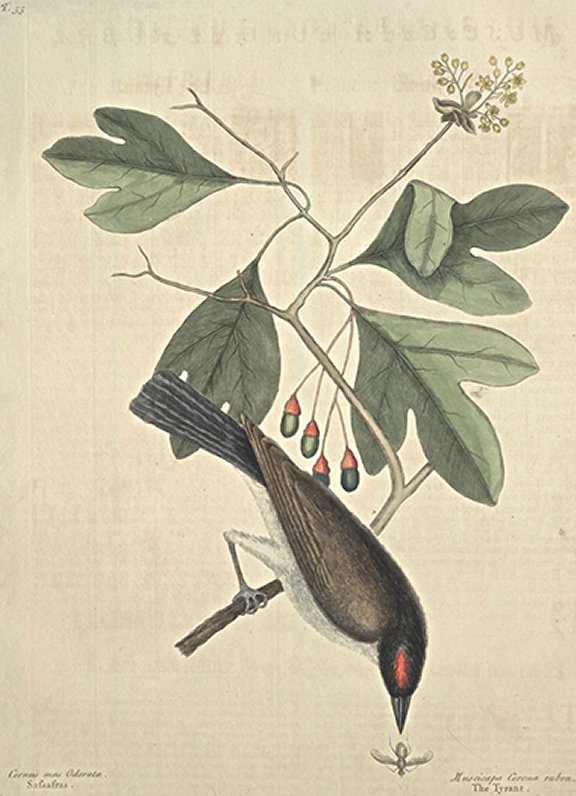Plate Number: I 55Muscicapa Corona Rubra: The Tyrant The Bill is broad, flat and tapering. The Crown of the Head has a bright red Spot, environ'd with black Feathers; which, by contracting, conceals the Red; but, when they are spread, it appears with much Lustre after the Manner of the Regulus cristatus. The Back, Wings and Tail are brown; the Neck, Breast and Belly white; the Legs and Feet black. There appears little or no Difference between the Cock and Hen. They appear in Virginia and Carolina about April, where they breed, and retire at the Approach of Winter. The Courage of this little Bird is singular. He pursues and puts to Flight all kinds of Birds that come near his Station, from the smallest to the largest, none escaping his Fury; nor did I ever see any that dar'd to oppose him while flying; for he does not offer to attack them when sitting. I have seen one of them six on the Back of an Eagle, and persecute him so, that he has turned on his Back into various Postures in the Air, in order to get rid of him, and at last was forc'd to alight on the Top of the next Tree, from whence he dared not move, till the little Tyrant was tired, or thought fit to leave him. This is the constant Practice of the Cock while the Hen is brooding: He sits on the Top of a Bush, or small Tree, not far from her Nest; near which if any small Birds approach, he drives them away; but the great Ones, as Crows, Hawks, and Eagles, he won't suffer to come within a Quarter of a Mile of him without attacking them. They have only a chattering Note, which they utter with great Vehemence all the Time they are fighting. When their Young are flown, they are as peaceable as other Birds. It has a tender Bill, and feeds on Infects only. They are tame and harmless Birds. They build their Nest in an open manner on low Trees and Shrubs, and usually on the Sassafras-Tree. Cornus mas odorata, folio trifido margine plano, Sassafras dictaThis is generally a small Tree; the Trunc usually not a Foot thick. The Leaves are divided into three Lobes by very deep Incisures. In March comes forth Bunches of small yellow Flowers with five Petals each; which are succeeded by Berries, in Size and Shape not unlike those of the Bay-Tree, hanging on red Footstalks, with a Calix like that of an Acorn; which Calix is also red. The Berries are at first green, and, when ripe, blue. These Trees grow in most Parts of the Northern Continent of America, and generally on very good Land. The Virtue of this Tree is well known, as a great sweetner of the Blood: I shall therefore only add, that in Virginia a strong Decoction of the Root has been sometimes given with good Success for an intermitting Fever. This Tree will hear our Climate, as appears by several now at Mr. Collinson's at Peckham, and at Mr. Grays in Fulham; where they have withstood the cold of several Winters. |